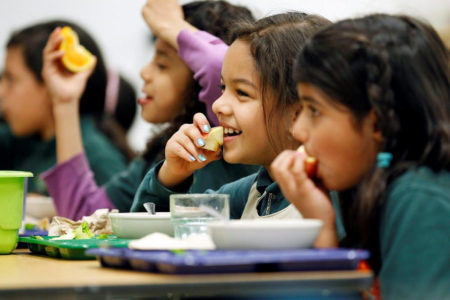
Share On Social!
Free school meals have been a staple for kids from low-income households for decades, especially Latino kids.
When the COVID-19 pandemic hit, unions and advocacy organizations successfully fought to bring universal free school meals to students learning from home, with federal support from the U.S. Department of Agriculture (USDA).
Then after several extensions, USDA funded school meals through June 30, 2022.
But what happens after that?
Let’s explore the current state of free school meals, the impact they have on Latino kids, and what the future holds.
UPDATE 2/4/22: The Biden administration announced the USDA will change its school nutrition standards for the 2022-2023 school year, reinstating health goals that were rolled back throughout the Trump administration on low-fat or nonfat non-flavored milks and limit the fat in sweet flavored milks.
The State of Free School Meals: Before COVID-19 Hit
The past few years have been turbulent for school nutrition and free school meals.
Under the Trump administration, USDA tried multiple times to weaken nutrition standards for schools in various ways.
They tried to cut back the Healthy, Hunger-Free Kids Act by allowing schools to serve refined grains over whole grains, flavored milk, and higher levels of salt in meals.
In 2019 and 2020, USDA tried to ease restrictions on sodium and whole-grain requirements in school meals, but a federal district judge struck it down due to violations of regulatory law.
In one instance, over 7,492 people—including members of Salud America!—submitted public comments to address concerns over a 2020 USDA proposal to weaken school food nutrition standards.
The State of Free School Meals: After COVID-19 Hit
Then when COVID-19 hit the U.S. in spring 2020 — especially impacting Latinos — many families were greatly impacted by food insecurity and switching to remote learning.
Schools had to react quickly to continue to help families that rely on free school meals to feed their children.
“Some urban and expansive rural districts even took the show on the road, directing school bus drivers to bring food to remote neighborhoods instead of bringing the children that lived there to school,” according to Education Week.
They were able to do so because of federal waivers from the USDA.
These waivers, first issued in spring 2020, allow schools to operate outside of cafeterias and provide free meals universally without needing to verify students’ eligibility for federal programs.

USDA extended the waivers in March 2021, and again in April 2021 through the 2021-2022 school year, ending June 30, 2022.
Federal support has been vital for getting free school meals to families when remote learning persisted in many areas of the country in 2021.
But due to staffing shortages, missing ingredients, increased costs, among other barriers, it’s been difficult to reach as many kids as before the pandemic.
“Schools served about 191 million lunches in February 2021, compared to about 490 million lunches in February 2020, according to the most recent federal data,” according to Education Week.
Now, some lawmakers and proponents of free school meals want to make free school meals universal for all students beyond the pandemic.
“While the extension of these short-term waivers will come as a relief to many families, without a permanent solution to provide free meals to all students, schools will eventually have to revert to the complicated myriad of paperwork and programs—where only some kids get to eat for free,” wrote the lawmakers of the Universal School Meals Program Act of 2021 in a bill summary, according to Education Week.
Universal free school meals have the ability to feed millions of low-income families, particularly Latino, immigrant families who may have been reluctant previously due to public charge.
How Do Free School Meals Impact Latinos?
About 25% of public-school students are Latino.
Unfortunately, Latino children often lack access to healthy school environments.
Their schools are inundated with unhealthy foods and drinks in school stores, snack lines, and vending machines and have weaker policies for nutrition, according to a Salud America! research review.
Latinos are also more likely to live in food swamps – areas with many unhealthy fast-food restaurants and a lack of grocery stores with healthier options, according to another Salud America! research review.

With fewer healthy options, Latinos are more likely to overconsume unhealthy food and have higher rates of obesity and disease among Latino children and adults.
That’s why free school meals can make a huge impact.
When Latino kids have access to free, healthy options, they’re lessening the chances for health complications later in life.
“Healthy school environments are paramount for the proper development of Latino kids, given the rising percentage of Latino students enrolled in public schools and their high rates of obesity,” said Dr. Amelie G. Ramirez, director of Salud America! and the Institute for Health Promotion Research at the UT Health San Antonio.
The Future of Free School Meals
Proponents hope that free school meals are here to stay.
USDA is also continuing to support the effort.
On Jan. 7, 2022, USDA announced an increase in funding to school meal programs.
“This move will put an estimated $750 million more into school meal programs across the nation this year, making sure federal reimbursements keep pace with food and operational costs, while ensuring children continue to receive healthy meals at school,” according to a USDA press release.
Advocates hope that legislation to permanently support universal school meals will pass once up for discussion in Congress.
“Amid pandemic uncertainties, school meals have remained a reliable source of nourishment for America’s students, supporting their health and achievement, while combatting food insecurity,” said Beth Wallace, president of the School Nutrition Association, according to a press release.
“However, persistent pandemic challenges threaten the stability of child nutrition programs that millions of American families depend on. Congress must take action to restore the financial and operational sustainability of school meal programs for the students they serve.”
How Can We Help Latino Kids Eat Healthy?
You can make a difference by being an advocate for healthy food in your area.
Download a Salud America! Health Equity Report Card!
The report card shows many local children live in food deserts, have low food access, and get SNAP food benefits. Then you can compare it to your state and to the country.
Email your Health Equity Report Card to community leaders and share it on social media. Then use it to make the case to address food insecurity and nutrition security where help is needed most!
Salud America! also created an Action Pack to help school leaders push for Water Bottle Fountains. This refillable water station can boost access to water for Latino and all kids, which is a healthier option than many sugary drinks offered in schools.
By The Numbers
142
Percent
Expected rise in Latino cancer cases in coming years



